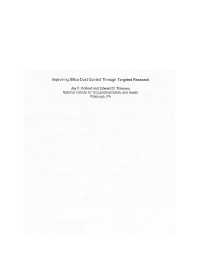Mining Publication: Improving Silica Dust Control Through Targeted Research
Original creation date: February 2002
NIOSH conducted a strategic planning effort to identify those areas in mining with the greatest research needs. Data analysis and stakeholder input identified the need to reduce worker exposure to respirable crystalline silica dust as a high priority area. MSHA dust sampling data were analyzed to target the mining commodities and occupations with the greatest percentage of samples containing silica above compliance levels. In response, the Pittsburgh Research Laboratory (PRL) has implemented a multi-faceted research program to improve silica dust control for these problematic commodities and occupations. A review of silica compliance trends, PRL silica research programs, and recent control technology developments are provided here.
Authors: JF Colinet, ED Thimons
Conference Paper - February 2002
NIOSHTIC2 Number: 20023178
2002 SME Annual Meeting, Feb 25-27, Phoenix, Arizona, preprint 02-189. Littleton, CO: Society for Mining, Metallurgy, and Exploration, Inc., 2002 Feb; :1-6
See Also
- Best Practices for Controlling Respirable Dust in Coal Mines
- Best Practices for Dust Control in Metal/Nonmetal Mining
- Control of Respirable Dust
- Dust Underfoot: Enclosed Cab Floor Heaters Can Significantly Increase Operator's Respirable Dust Exposure
- Evaluation of the Approach to Respirable Quartz Exposure Control in U.S. Coal Mines
- Field Assessment of Control Techniques and Long-Term Dust Variability for Surface Coal Mine Rock Drills and Bulldozers
- Improved Drill Shroud Capture of Respirable Dust Utilizing Air Nozzles Underneath the Drill Deck
- Improving the Performance of Fan-Powered Dust Collectors in Stone-Cutting Applications
- Laboratory Testing To Quantify Dust Entrainment During Shield Advance
- Respirable Dust
- Page last reviewed: 9/21/2012
- Page last updated: 9/21/2012
- Content source: National Institute for Occupational Safety and Health, Mining Program


 ShareCompartir
ShareCompartir
